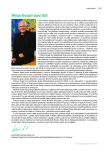The difference and ratio between serum concentrations of natrium and chlorides in patients with hyponatremia
Authors:
Otto Schück; Miroslava Horáčková
Authors‘ workplace:
Interní klinika 2. LF UK a FN v Motole, Praha
Published in:
Vnitř Lék 2016; 62(7-8): 629-634
Category:
Reviews
Overview
The differential diagnosis of hyponatremia is often difficult. This most frequently occurring disorder of the water and electrolyte metabolism is frequently connected with deviations relating to the acid-base balance (ABB). This survey analyzes the relationship between the changes of the volume of body fluids and ABB and infers to what extent the analysis of combinations of the two disorders can support the differential diagnosis of different forms of hyponatremia (differentiation between the dilution vs. depletion forms). The changes of the total water volume (CTV) and ABB may be presented at the same time in the values of the difference and ratio between serum concentrations of natrium and chlorides (SNa+ – SCl-; SNa+/SCl-). The changes of these quantities are analyzed in the models of pathologies connected through hyponatremia and ABB related deviations: (i) retention of solute-free water (hyponatremia associated with dilution acidosis); (ii) retention Na+ in combination with water retention (hyponatremia associated with dilution and hyperchloremic acidosis); (iii) depletion Na+ combined with water depletion (depletion hyponatremia combined with hypochloremic alkalosis), and (iv) combination of dilution and depletion (hyponatremia which may be associated with different ABB related deviations). This survey specifies the extent to which the applied models are consistent with the existing clinical findings and experience. The examinations SNa+ – SCl- and SNa+/SCl- rely only on routinely used laboratory test methods. Monitoring of these quantities may contribute to continuous assessment of the effect of a chosen therapy.
Key words:
acid-base balance – depletion hyponatremia – differential diagnosis of hyponatremia – dilution hyponatremia – hyponatremia – retention of solute-free water – body fluid volumes
Sources
1. Nagaoka D, Nessan jr. AP, Marcel AT et al. The use of sodium-chloride difference and chloride-sodium ratio as strong ion difference surrogates in the evaluation of metabolic acidosis in critically ill patients. J Crit Care 2010; 25(3): 525–531.
2. Kurt A, Ecevit A, Ice DA et al. The use of chloride-sodium ratio in the evaluation of metabolic acidosis in critically ill neonates. Eur J Pediatr 2012, 171(6): 963–969.
3. Story DA, Morinatsu H, Bellomo R. Strong ion, weak acids an base excess: a simplified Fencl-Stewart approach to clinical acid-base disorders. Br J Anaesth 2004; 92(1): 54–60.
4. Story DA, Tosolini A, Bellomo R et al. Plasma acid-base changes in chronic renal failure: a Stewart analysis. Int J Artfef Organs 2005; 28(10): 961–965.
5. Klaboch J, Opatrná S, Matoušovic K et al. Acid-base balance in peritoneal dialysis patients: a Stewart-Fencl analysis. Ren Fail 2009; 31(8): 625–632.
6. Havlín J, Matoušovic K, Schück O et al. The use of sodium-chloride difference and chloride-sodium ratio in critically ill patients. Eur J Pediatr 2012; 171(11): 1719. Comment on The use of chloride-sodium ratio in the evaluation of metabolic acidosis in critically ill neonates. [Eur J Pediatr 2012]
7. Kříž J, Schück O, Horáčková M. Hyponatremia in spinal cord injury patients: a new insight in to differentiating the dilution and depletion form. Spinal Cord 2015; 53(4): 291–296.
8. Mitchell l, Halperin ML, Goldstein MB. Fluid, Electrolyte and Acid Base Physiology: A Problem-Based Approach. 3rd ed. WB Saunders Comp: Philadelphia 1999.
9. Haskins SG, Hopper K, Rezende ML. The acid-base impact of free water removal from, and addition to, plasma. J Lab Clin Med 2006; 147(3): 114–120.
10. Fencel V, Jabor A, Kazda A. Diagnosis of metabolic acid-base disturbances in critically ill patients. Am J Resp Crit Care Med 2000; 162(6): 2246–2251.
11. Jabor A (ed). Vnitřní prostředí. Grada: Praha 2008. ISBN 978–80–247–1221–5.
12. Seifter JL. Integration of Acid-Base and Electrolyte Disorders. New Engl J Med 2014; 371(19): 1821–1831.
13. Šmahelová R, Schück O, Koťátko J. Osmotická činnost ledvin při srdečním selhávání. Vnitř Lék 1958; 4(3): 206–212.
14. Schück O, Šmahelová R. La funzione osmotica dei reni nell´insufficienza cardiaca cronica. Minerva Nefrol 1958; 5(3): 3–7.
15. Schück O, Hoenig V, Šmahelová R. Liver cirrhosis and the elaboration of hypertonic urine. Rev Czechoslov Med 1960; 6(2): 112–117.
16. Berl T. Vasopressin Antagonists. New Eng J Med 2015; 372(23): 2207–2216.
17. Verbrugge FH, Steels P, Grieten L et al. Hyponatremia in acute decompensated heart failure. J Am Col Cardiol 2015; 65(5): 480–492.
18. Spasovski G, Vanholder R, Allolis B et al. [Hyponatraemia Guideline Development Group]. Clinical practice guidelines on diagnosis and treatment of hyponatraemia. Nephrol Dial Transpl 2014; 29(Suppl 2): 2S1–2S39. Dostupné z DOI: <http://dx.doi.org/10.1093/ndt/gfu040>
19. Verbalis JG, Goldschmith SR, Greenberg A et al. Diagnosis, evaluation and treatment of hyponatremia: expert panel recommendations. Am J Med 2013; 126(10 Suppl 1): S1-S42.
20. Gottfriedová H, Schück O, Horáčková M et al. Hyponatremie a změny acidobazické rovnováhy u kandidátů transplantace jater a možnosti jejich ovlivnění diuretiky. Gastroent Hepatol 2016; 70: (Suppl 1): S13.
Labels
Diabetology Endocrinology Internal medicineArticle was published in
Internal Medicine

2016 Issue 7-8
Most read in this issue
- Treatment of liver cirrhosis – actually possibility of ambulant internist
- Sepsis – how to recognize and what to focus on – back to basics in the light of the new definition
- The skin – a mirror of internal diseases
- Prevention and therapy of sarcopenia in the ageing
